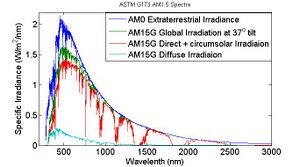No edit summary |
J.M.Pearce (talk | contribs) |
||
| Line 35: | Line 35: | ||
=Calibration and Verification= | =Calibration and Verification= | ||
=References= | |||
<references/> | |||
[[category:Queens Applied Sustainability Group]] | [[category:Queens Applied Sustainability Group]] | ||
Revision as of 21:56, 13 July 2011
Overview and Scope
The Goal for this Open Source Solar Spectrum Analyzer was to create a standalone system which when fitted with a Spectrometer, would allow for the Sun to be actively tracked and followed across the sky allowing for its Direct and Diffuse radiation to be measured . These measurements occur every hour and have enough resolution to span the UV-VIS to NIR spectrum.
In order to accomplish this, Queen's University joined up with the La Universidad Privada Boliviana in Cochabamba, Bolivia. This partnership allowed for, in addition to the different location, an insight into how International Collaboration can be implemented as well as ways to increase its productivity and efficiency.
Our systems would be designed to be as similar as possible with an exception for there individual spectrometers. This will allow us to get comparable data from both sites in order to compare the Suns radiation.
This page describes how to build an automated spectrometer for recording solar spectra. It includes links to CAD files, design, software etc. It list all the components with links to purchase locations, includes calibration protocols, etc. Everything that is needed to replicate the two examples at UPB and in Canada....and a link to the data streams.
Solar Theory
The attenuation and transmission of light in the earth's atmosphere is important in many feilds including: photovoltaics, agriculture, weather prediction and climate research. Due to the non-homegeneity of the earth's atmosphere and constantly changing solar geometry, the solar resource is variable and can have very different effects at geographically disparate sites on the planet. Solar irradiation is composed of a spectrum of light, which can broadly be divided into UV, Visible, and Near Infared (NIR) light. The light present at the edge of the earth's atmosphere, at what is called a 0 Air Mass (AM0) is defined as the extraterrestrial insolation (Go), which is a consistently varying quantitiy, but generally defined as 1366.1 W/m^2 for engineering applications [1]. As the extraterrestrial spectrum travels throught eh earths atmosphere, it is attenuated by a vareity of atmospheric constituents, including in decending order of their relative effects on solar transmission for a clear (cloudless) sky: Aerosols (mie scattering), Particulates (Rayleigh Scattering), Water Vapour, Ozone, Carbon Dioxide, and Oxygen. The level of the attenuation due to these atmospheric components is dependant on their relative concentrations and on the optical path length through which the solar irradiaion passes. If the sun is directly overhead, the optical path length is said to be one air mass (AM1) as the solar elevation above teh horizon decreases, the sun's irradiance must pass through a larger distance before reaching the surface, and therefore the air mass will increase. For many solar photovoltaic applications, the airmass of 1.5 (AM1.5) with an associated irradiance of 1000 W/m^2 (1 sun) is consitered to be a standard atmospheric condition. A summary of the atmospheric consitituents which can afford this condiiton and for a definition of the standard AM1.5 atmosphere, a comprehensive description can be found here .

Solar attenuation
The attenuation of the solar resource in the atmosphere effects
Construction
Electronics and Controls
Calibration and Verification
References
- ↑ ([1] C.A. Gueymard, The sun’s total and spectral irradiance for solar energy applications and solar radiation models, Solar Energy. 76 (2004) 423-453)